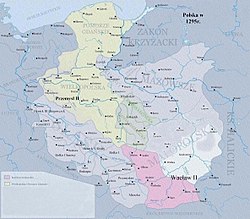Seniorate Province
| Duchy of Kraków | ||||||||||
| Księstwo krakowskie (pl) | ||||||||||
| Province of Poland | ||||||||||
|
||||||||||
|
Duchy of Kraków (pink) upon the coronation of
King Przemysł II in 1295 |
||||||||||
| Capital | Kraków | |||||||||
| Religion | Roman Catholic | |||||||||
| Government | Duchy | |||||||||
| Historical era | High Middle Ages | |||||||||
| • | Established | 1138 | ||||||||
| • | Senior Władysław II exiled |
1146 | ||||||||
| • | Split off Kuyavia | 1173 | ||||||||
| • | Split off Gniezno and Kalisz |
1181 | ||||||||
| • | Lost Pomerelia | 1227 | ||||||||
| • | Incorporated | 1320 | ||||||||
|
||||||||||
Seniorate Province, also known as the Senioral Province (Polish: Dzielnica senioralna), Duchy of Kraków (Księstwo krakowskie), Duchy of Cracow, Principality of Cracow, Principality of Kraków, was the superior among the five provinces established in 1138 according to the Testament of Bolesław III Krzywousty. It existed during the period of fragmentation of Poland until 1320, centered at Kraków in Lesser Poland. The Seniorate Province was supposed to be ruled by the rotating head of the royal Piast dynasty, a principality that he held as overlord (Senior Prince or High duke, princeps) of the other Polish dukes.
The senioral principle established in the testament stated that at all times the eldest member of the dynasty was to have supreme power over the rest (Dux, the Dukes) and was also to control an indivisible "Seniorate Province". In 1138 Bolesław's III eldest son Władysław II, took up the rule over a vast strip of land running north-south down the middle of Poland, composed of:
The High Duke resided at Kraków, Poland's capital since 1038. The Senior's prerogatives also included control over the Duchy of Silesia and his Pomerelian vassals at Gdańsk in eastern Pomerania. The Senior was tasked with defense of borders, the right to have troops in provinces of other Dukes, carrying out the foreign policy, supervision over the clergy (including the right to nominate bishops and archbishops), and minting the currency.
...
Wikipedia


